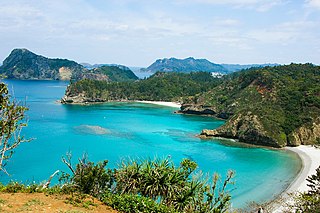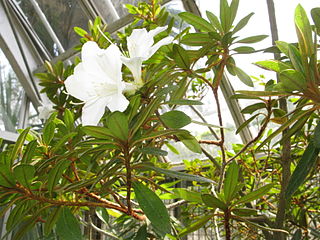
The Bonin Islands, also known as the Ogasawara Islands (小笠原諸島), is a Japanese archipelago of over 30 subtropical and tropical islands located around 1,000 kilometers (620 mi) SSE of Tokyo and 1,600 kilometers (1,000 mi) northwest of Guam. The group as a whole has a total area of 84 square kilometers (32 sq mi) but only two of the islands are permanently inhabited, Chichijima and Hahajima. Together, their population was 2,560 as of 2021. Administratively, Tokyo's Ogasawara Subprefecture also includes the settlements on the Volcano Islands and the Self-Defense Force post on Iwo Jima. The seat of government is Chichijima.

Ogasawara is a village in Ogasawara Subprefecture, Tokyo Metropolis, Japan, that governs the Bonin Islands, Volcano Islands, and three remote islands.

Hahajima, Haha Jima, or Haha-jima is the second-largest island within the Bonin or Ogasawara Islands SSE of the Japanese Home Islands. The steeply-sloped island, which is about 21 km2 (8 sq mi) in area, has a population of 440. It is part of Ogasawara Village in Ogasawara Subprefecture, which is approximately 1,000 km (620 mi) south of Tokyo, Japan.

Ogasawara National Park is a national park in the Ogasawara Islands, located approximately one thousand kilometres to the south of Tokyo, Japan. The park was established in 1972 within the municipality of Ogasawara, itself part of Tokyo. In 2011, the Ogasawara Islands were inscribed upon the UNESCO World Heritage List.

The Bonin white-eye is a small species of songbird endemic to the Bonin Islands of Japan. It is the only species in the monotypic genus Apalopteron. The taxonomic affinities of the Bonin white-eye were a long-standing mystery and it was formerly placed with the bulbuls, babblers and more recently with the honeyeaters, during which it was known as the Bonin honeyeater. Since 1995 it is known to be a white-eye in the family Zosteropidae, that is closely related to the golden white-eye of the Marianas Islands.

Gastrodia, commonly known as potato orchids, is a genus of terrestrial leafless orchids in the family Orchidaceae, about ninety of which have been described. Orchids in this genus have fleshy, upright stems and small to medium-sized resupinate flowers with narrow sepals and petals. They are native to Asia, Australia, New Zealand, central Africa, and various islands of the Indian and Pacific Oceans.

Chikusichloa is a genus of Asian plants in the grass family.

Talipariti is a genus of plants in the mallow family Malvaceae. It consists of 22 species, which are exclusively tropical except for one species whose range extends into temperate areas of Japan and Korea. Most authors now treat these species as part of the genus Hibiscus, in which case they form the section Hibiscus sect. Azanzae.

Crepidiastrum is an Asian genus of flowering plants in the family Asteraceae.

Sanguisorba hakusanensis, the Japanese Burnet, is a species of flowering plant in the family Rosaceae, native to Japan. Its Japanese name means "coming from Haku", a mountain in Japan.

Allium thunbergii, Thunberg's chive or Thunberg garlic, is an East Asian species of wild onion native to Japan, Korea, and China. It grows at elevations up to 3000 m. The Flora of China recognizes A. tunbergii and A. stenodon as separate species, but more recent sources combine the two.

Sagittaria pygmaea, commonly known as the dwarf arrowhead or pygmy arrowhead, is an aquatic plant species. It is a perennial herb producing by means of stolons. Leaves are linear to slightly spatula-shaped, not lobed, up to 30 centimetres long.

Cardiocrinum cordatum, also known as Turep in the Ainu Languages, is a Northeast Asian species of plants in the lily family. It is native to Japan and to certain Russian islands in the Sea of Okhotsk.

Arnica mallotopus is a species of flowering plant in the family Asteraceae. It is native to Japan.
Erigeron alpicola is an Asian species of flowering plants in the family Asteraceae. It is native to Japan, to Jilin Province in China, and to the Kamchatka Peninsula in Russia.
The Bonin greenfinch, also known as the Ogasawara greenfinch, is a small passerine bird in the finch family Fringillidae that is endemic to the Ogasawara Islands of Japan, where it is found on the Bonin Islands and Volcano Islands. It was formerly considered a subspecies of the grey-capped greenfinch and some authorities consider it as such, but a 2020 analysis found it likely to represent a distinct species that diverged from C. sinica about 1.06 million years ago, and the International Ornithological Congress now recognizes it as such, making it the eleventh endemic species in Japan. There are fewer than 400 individuals in the population and it is considered critically endangered by the Japanese government, necessitating protection. According to the Yamashina Institute for Ornithology, as of December 2021, the Ogaswara greenfinch is Japan's most endangered bird.

Vaccinium boninense is a species of flowering plant in the family Ericaceae that is endemic to the Bonin Islands, Tōkyō Metropolis, Japan.

The Journal of Plant Research is a bimonthly peer-reviewed scientific journal of botany published on behalf of the Botanical Society of Japan by Springer Science+Business Media. Its predecessor, The Botanical Magazine of Tokyo, first published in 1887, ran until volume 105 in 1992; during this period, over 4,900 plant names were first published in its pages. The journal obtained its current name in 1995.

Rhododendron boninense is a species of flowering plant in the family Ericaceae that is endemic to the Bonin Islands of Tōkyō Metropolis, Japan.

The Bonin Islands are an archipelago of over 30 subtropical and tropical islands, some 1,000 kilometres directly south of Tokyo, Japan and 1,000 miles northwest of Guam.
















